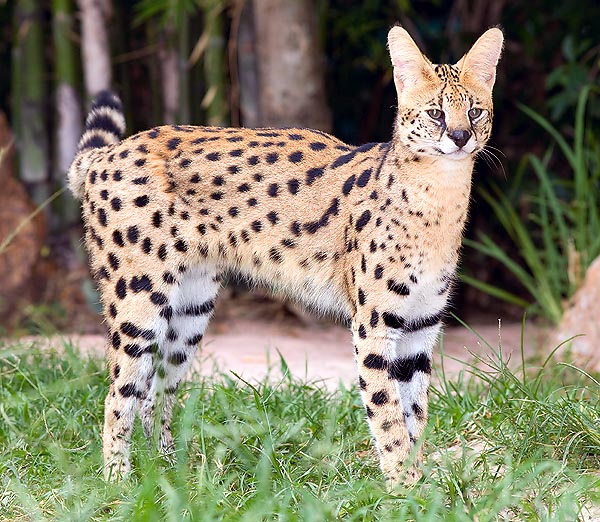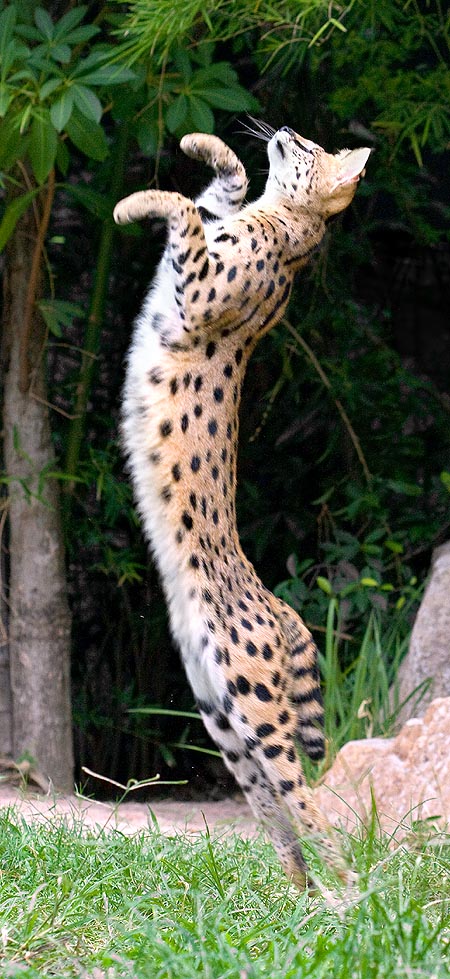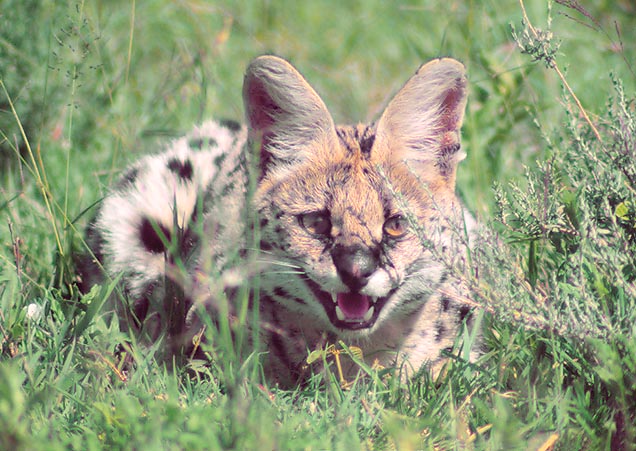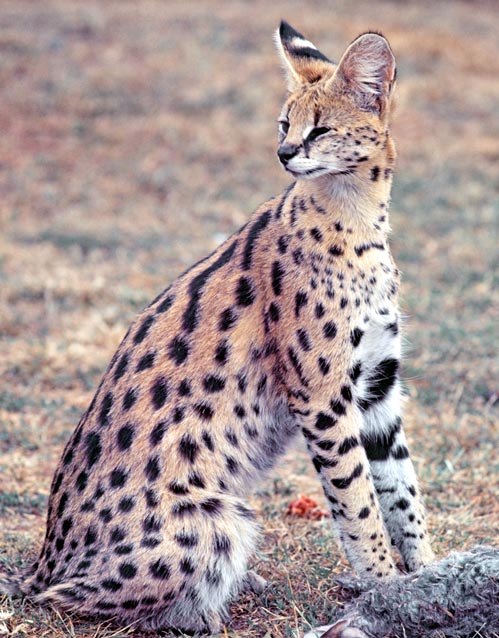Family : Felidae

Text © Dr. Gianni Olivo

English translation by Mario Beltramini

The serval (Leptailurus serval) is the tallest small African feline © Giuseppe Mazza
The Serval (Leptailurus serval Schreber, 1776) is an African maculated feline of medium-small size, characterized, at first sight, by the long legs, which make it the tallest among the small felines of the African continent, that is why my tracer calls it, in fact, ikati elizonzo, cat with slender and long legs, like a bird.
The overall appearance, slim and graceful, reminds therefore, vaguely, the silhouette of the cheetah, resemblance enhanced by the two black stripes which decorate the muzzle, when seen from the front.
The ears are prominent and of big size in comparison with the head, that appears somewhat small and rounded, are very mobile and allow to locate the prey from the noise, even if minimal, produced, as they operate as a “stereo” locator in a habitat, that of the tall grasses, which greatly reduces the visibility.
The dimensions are large for a feline with a modest weight (10-17 kg for the male and 8-12 for the female).
The shoulder height may reach the 65 cm (as an average, 55); length from the point of the muzzle to the root of the tail of 70-100 cm to which we have to add the tail length, rather short, 25-35 cm, whereby the total length may reach the 130 cm.

The long paws allow spectacular bounces, also vertical © Giuseppe Mazza
The background colouration varies depending on the zones and even inside a same zone, as it tends to be darker in more humid habitats, with less evident spots, whilst in drier zones the background colour tends to the reddish or the bronze or yellow, with more evident and clear spots.
The tail is striated with dark transversal bands and often the paws, shoulders and neck tend also to be streaked. On the sides are present big and neat dark spots, but there are specimens called “freckled”, with smaller spots (western Africa). Odorous glands with marking function do not seem to be present.
The serval is mainly a diurnal hunter (even if it may be active during the night) of rodents, among which stand the Veld-rats and the Grass-rats (Otomys, Arvicanthis) but it may snare also birds frequenting the grassy savannah and the prairies, ideal hunting ground for this feline. The long limbs are not done so much for the running, as is the case of the cheetah, but for sudden jumps, also vertical, with which the feline seizes the birds just gotten up from the grass.
Furthermore, where the grass is high but not more than 50-60 cm, its size allows seeing further than the preys it looks for, allowing it, with a jump, to pounce on the unaware rodent.
The hunting technique is similar to the cats and, in some ways, also to the jackals: localized a mouse by the hearing and gotten close to it silently, the animal jumps up and forward, landing with the forelimbs on the prey.
In the case of an attack to a bird just stood up, the serval may perform spectacular jumps up to more than two metres of height, turn on itself while in the air, strike with sudden blows of a paw, also laterally, trying to slam the bird to the ground. If the blow fails, usually it gets away looking for another prey, but at times it shows off on a series of jumps which remind the bouncing of a rubber ball.
The choice of the preys is, however, ampler, as it includes also the aquatic birds which it does not hesitate in pursuing in the water, lizards, batrachians and fishes. In my reserve I saw, once, a serval jumping in the high grass at the side of a trail and crossing the same, frightened by my arrival, with a serpent in its mouth (I believe it was a grass snake). In another occasion, I saw one seizing an elephant shrew. Often, after the seizing of a rodent, the serval plays with the prey before eating the same, utilizing it as a ball or a clew and throwing it in the air, then catching it on the fly.
The prey may be eaten on the spot or carried in a hidden and safe place, depending on the confidence and the feeling of security or of danger it feels. The small preys, like mice and shrews, may be eaten entire, whilst the meal with bigger preys usually starts from the head or the back limbs.
Also big birds, even storks or cranes may be preys of this feline and once I found a Common duiker (Sylvicapra grimmia) killed by a serval. At that moment I thought that the antelope had been killed by a caracal, but, while examining closer its traces, I noticed that the marks of the “fingertips” were rather close to the pad (let’s call it “palm”), whilst in the caracal footprint, of similar size (5 or 6 cm) the marks of the fingers are more widely spaced from the pad.

Hidden in the grass it avoids the gaze while observing its preys © Giuseppe Mazza
Among the felines, cheetah apart, the serval is probably the most diurnal, as it prefers for its activities the hours of the early morning and late afternoon. During the days without sun or cold, it may keep active for the whole day, whereas it sleeps during the night, at least for part of the same, but it is often encountered while hunting also in the darkness and in such case its preys are the rock rabbits, along with other smaller nocturnal rodents.
For what distribution and habitat are concerned, the serval is present in a good part of Africa wherever this offers grassy extensions, in North Africa it is reported in Morocco, whilst, for the rest, it is confined to the sub-Saharan Africa.
It is met in a wide extent going from western Africa through the Central African Republic, up to Somalia and Ethiopia, excluding the arid zones of the extreme Horn of Africa, the pluvial forest and the desert; it colonizes then Kenya, Tanzania and the region of the Great Lakes and then descends, always bordering the pluvial forest, where is absent, up to Zambia, Angola, Zimbabwe, Mozambique, Malawi and South Africa. It needs grassy areas, possibly bordering the gallery forest or near the water and loves the mountain prairies interrupted by boulders and rocks, which shelter a huge variety of preys.

It eats many animals, but the choice preys are the rabbits © Giuseppe Mazza
It is a solitary and territorial animal and both sexes mark, with jets of urine, the herbs or shrubs or impregnate with saliva the stems, rubbing the muzzle against them, but they do not have smell glands apt for marking the territory.
The faeces or droppings are similar as shape to those of the other felines, i.e. with elongated shape and often segmented, pointed at one extremity and truncated at the opposite, little smaller than those of the caracal, with a maximum diameter of 1 or 1,5 cm.
These faeces contain often hair or feathers and small remains of bones, but less frequently become white with the time than those of other predators which eat big quantities of bones.
The territory is defended but the most of the times this is done with ritualized behaviours which rarely end in a serious fight.
As it is a solitary animal, the only couples which may be observed are, for some days, male and female in oestrum, which may also go hunting together, but the bond is much labile and the union dissolves in a few days.
The gestation lasts from two to two months and a half, after which the female delivers a litter of 2 or 3 cubs which, at the beginning, remain hidden in some thick or in a ravine.
Where are more powerful predators, the cubs are often moved, in way to reduce the possibility they are discovered, while the mother hunts and then carries the food to the newborn.
In any case, in some zones, the mortality connected with the predators is high and in such areas the servals are much more elusive and wary: in our reserve, where the leopards abound, the serval is a rather rare encounter, even if its traces are frequently observed.
Common names. In isiZulu: ikati elizonzo (cat with long and lean legs); in Afrikaans: serval.
